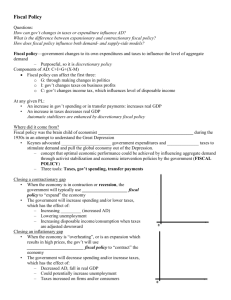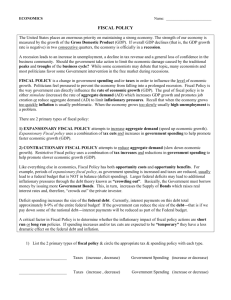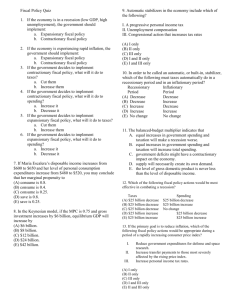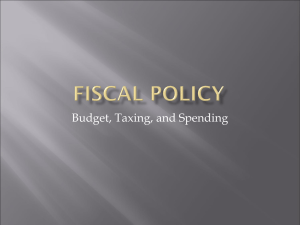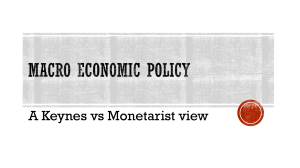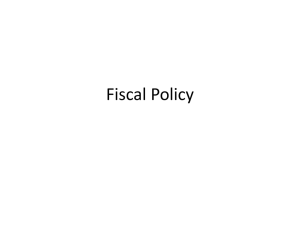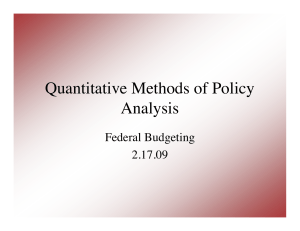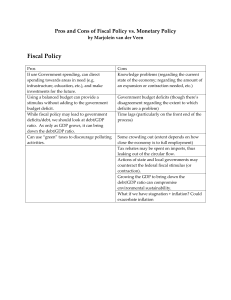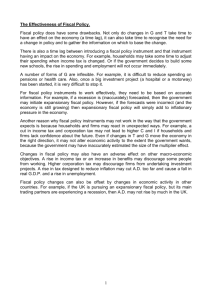J. Mon. March 24--FISCAL POLICY PRACTICE PROBLEMS
advertisement
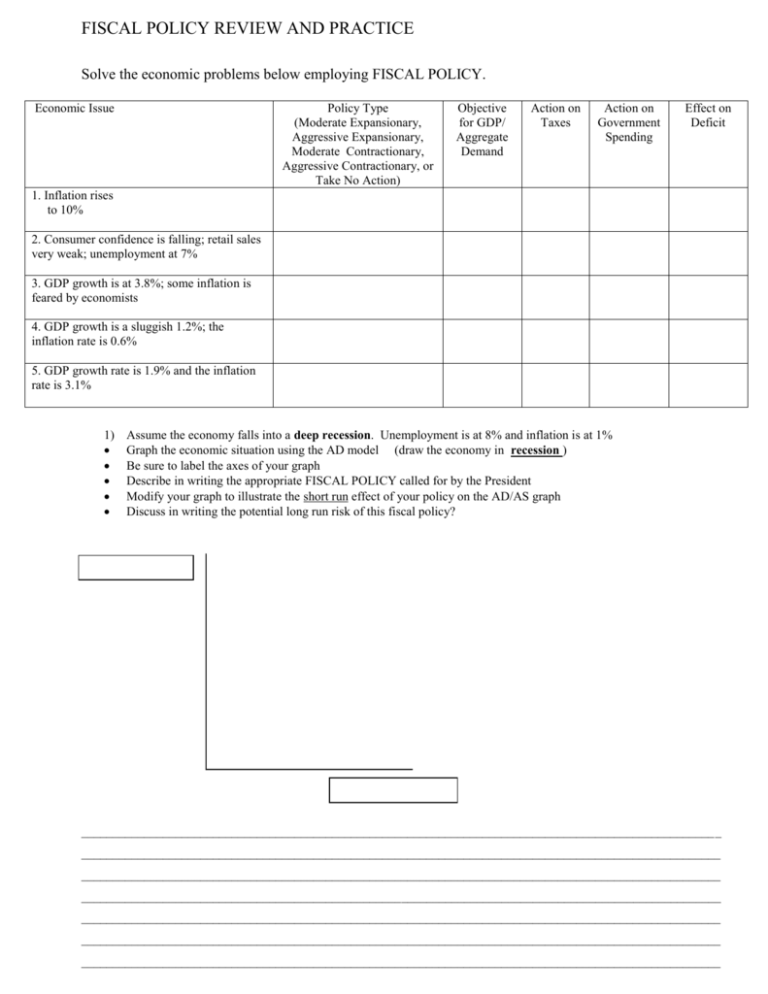
FISCAL POLICY REVIEW AND PRACTICE Solve the economic problems below employing FISCAL POLICY. Economic Issue Policy Type (Moderate Expansionary, Aggressive Expansionary, Moderate Contractionary, Aggressive Contractionary, or Take No Action) Objective for GDP/ Aggregate Demand Action on Taxes Action on Government Spending Effect on Deficit 1. Inflation rises to 10% 2. Consumer confidence is falling; retail sales very weak; unemployment at 7% 3. GDP growth is at 3.8%; some inflation is feared by economists 4. GDP growth is a sluggish 1.2%; the inflation rate is 0.6% 5. GDP growth rate is 1.9% and the inflation rate is 3.1% 1) Assume the economy falls into a deep recession. Unemployment is at 8% and inflation is at 1% Graph the economic situation using the AD model (draw the economy in recession ) Be sure to label the axes of your graph Describe in writing the appropriate FISCAL POLICY called for by the President Modify your graph to illustrate the short run effect of your policy on the AD/AS graph Discuss in writing the potential long run risk of this fiscal policy? ______________________________________________________________________________________________________ ______________________________________________________________________________________________________ ______________________________________________________________________________________________________ ______________________________________________________________________________________________________ ______________________________________________________________________________________________________ ______________________________________________________________________________________________________ ______________________________________________________________________________________________________ ECONOMICS Name: ________________________ FISCAL POLICY The United States places an enormous priority on maintaining a strong economy. The strength of our economy is measured by the growth of the Gross Domestic Product (GDP). If overall GDP declines (that is, the GDP growth rate is negative) in two consecutive quarters, the economy is officially in a recession. A recession leads to an increase in unemployment, a decline in tax revenue and a general loss of confidence in the business community. Should the government take action to limit the economic damage caused by the traditional peaks and troughs of the business cycle? While some economists may debate that topic, many economists and most politicians favor some Government intervention in the free market during recessions. FISCAL POLICY is a change in government spending and/or taxes in order to influence the level of economic growth. Politicians feel pressured to prevent the economy from falling into a prolonged recession. Fiscal Policy is the way government can directly influence the rate of economic growth (GDP). The goal of fiscal policy is to either stimulate (increase) the rate of aggregate demand (AD) which increases GDP growth and promotes job creation or reduce aggregate demand (AD) to limit inflationary pressures. Recall that when the economy grows too quickly inflation is usually problematic. When the economy grows too slowly usually high unemployment is a problem. There are 2 primary types of fiscal policy: 1) EXPANSIONARY FISCAL POLICY attempts to increase aggregate demand (speed up economic growth). Expansionary Fiscal policy uses a combination of tax cuts and increases in government spending to help promote faster economic growth (GDP). 2) CONTRACTIONARY FISCAL POLICY attempts to reduce aggregate demand (slow down economic growth). Restrictive Fiscal policy uses a combination of tax increases and reductions in government spending to help promote slower economic growth (GDP). Like everything else in economics, Fiscal Policy has both opportunity costs and opportunity benefits. For example, periods of expansionary fiscal policy, as government spending is increased and taxes are reduced, usually lead to a federal budget that is NOT in balance (deficit spending). Larger federal deficits may lead to additional inflationary pressures through the debt theory known as “crowding out”. Basically, the Government must borrow money by issuing more Government Bonds. This, in turn, increases the Supply of Bonds which raises real interest rates and, therefore, “crowds out” the private investor. Deficit spending increases the size of the federal debt. Currently, interest payments on this debt total approximately 8-9% of the entire federal budget! If the government can reduce the size of the debt---that is if we pay down some of the national debt---interest payments will be reduced as part of the Federal budget. A critical factor in Fiscal Policy is to determine whether the inflationary impact of fiscal policy actions are short run or long run policies. If spending increases and/or tax cuts are expected to be “temporary” they have a less dramatic effect on the federal debt and inflation. 1) List the 2 primary types of fiscal policy & circle the appropriate tax & spending policy with each type. _______________________ Taxes (increase , decrease) Government Spending (increase or decrease) _______________________ Taxes (increase , decrease) Government Spending (increase or decrease)
